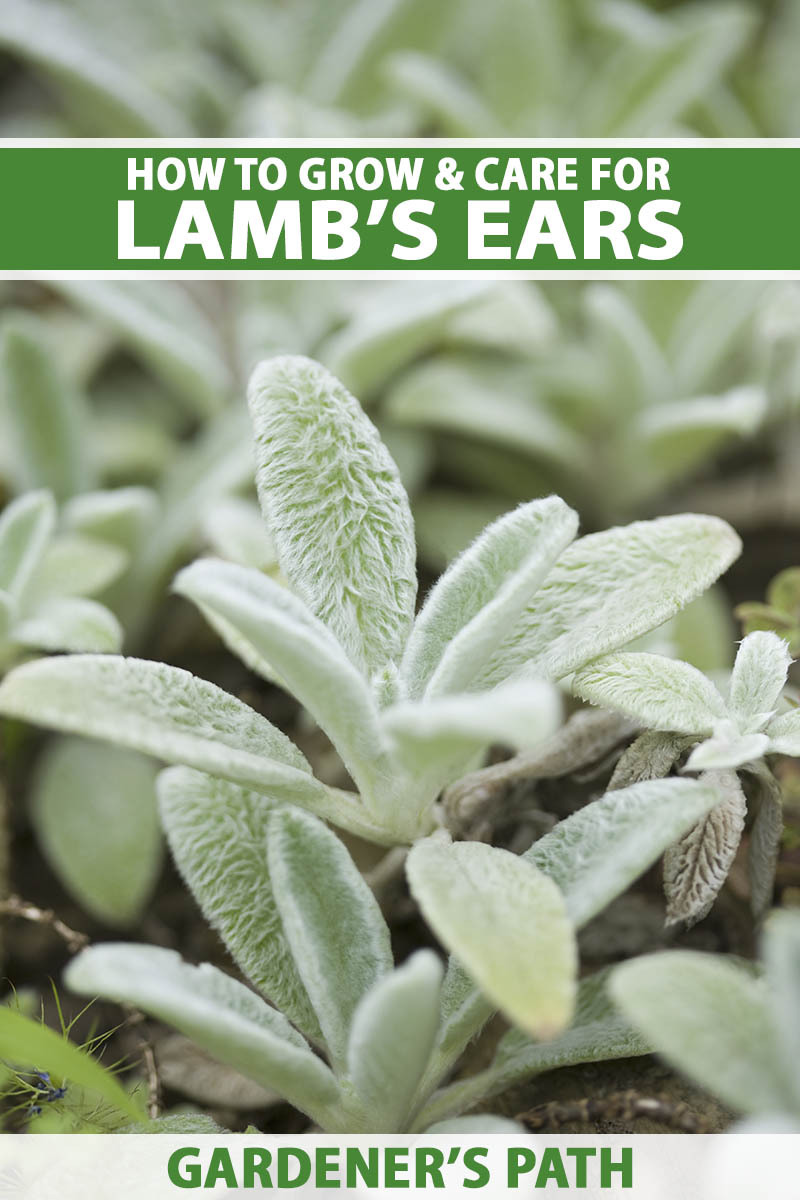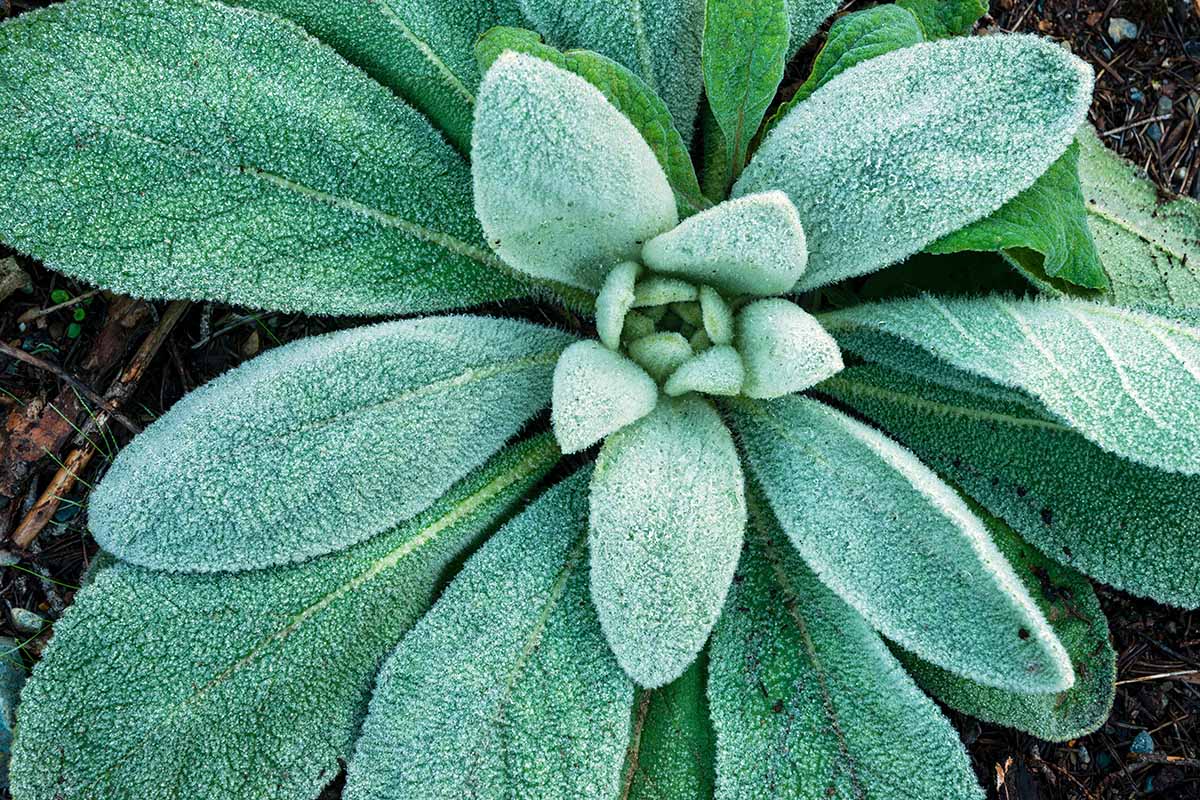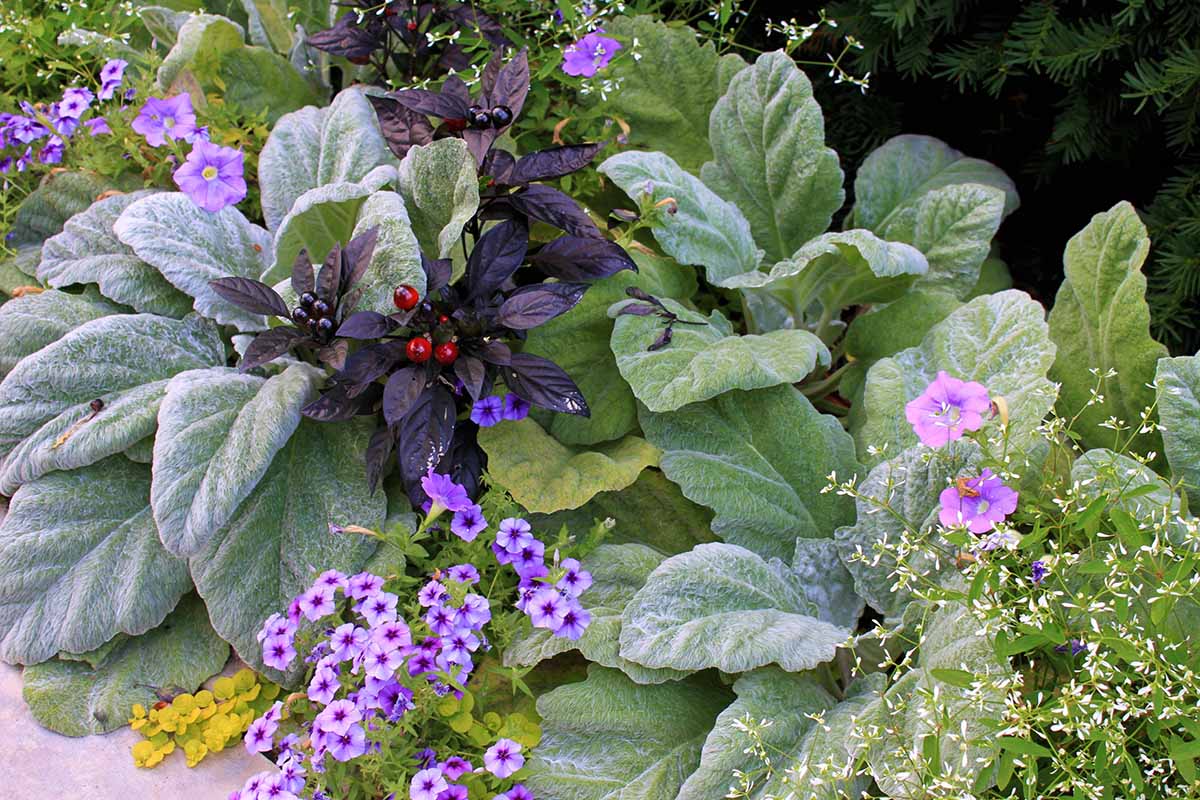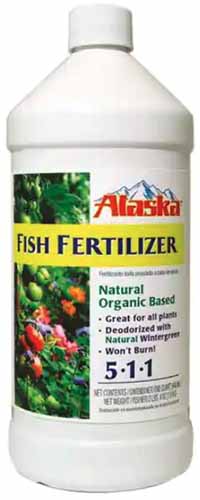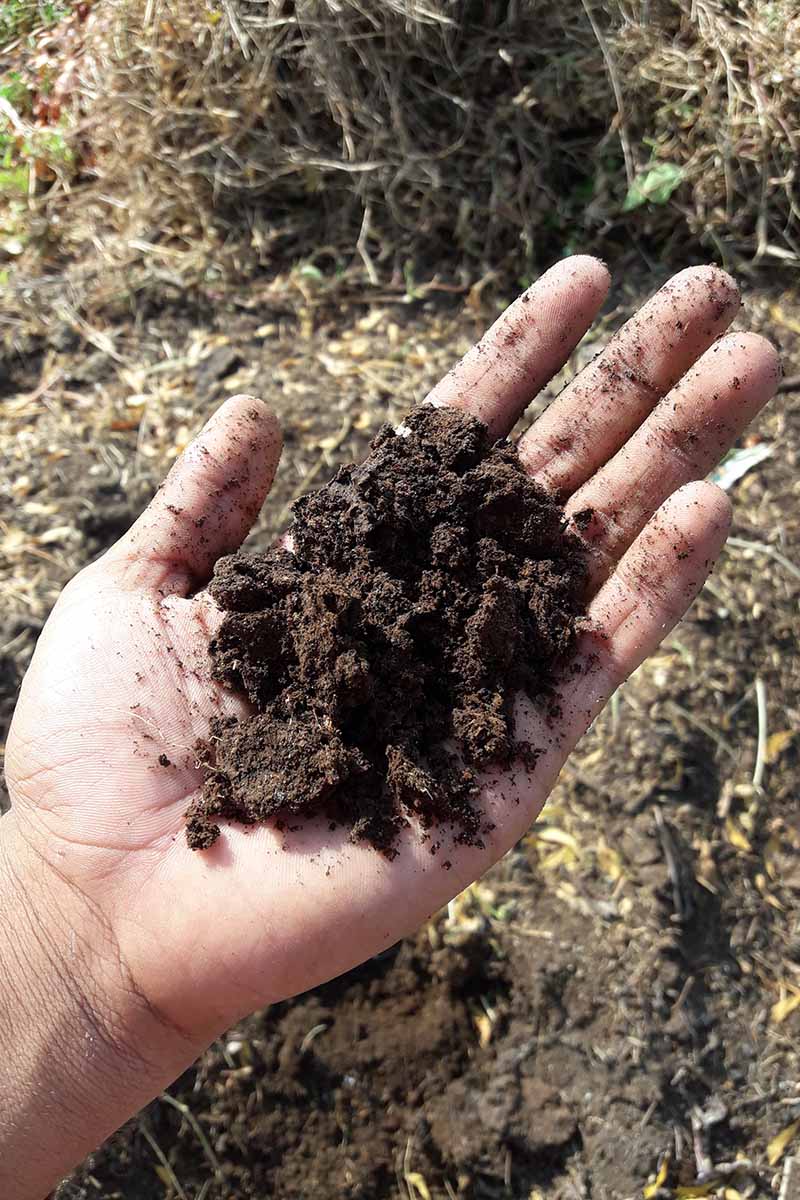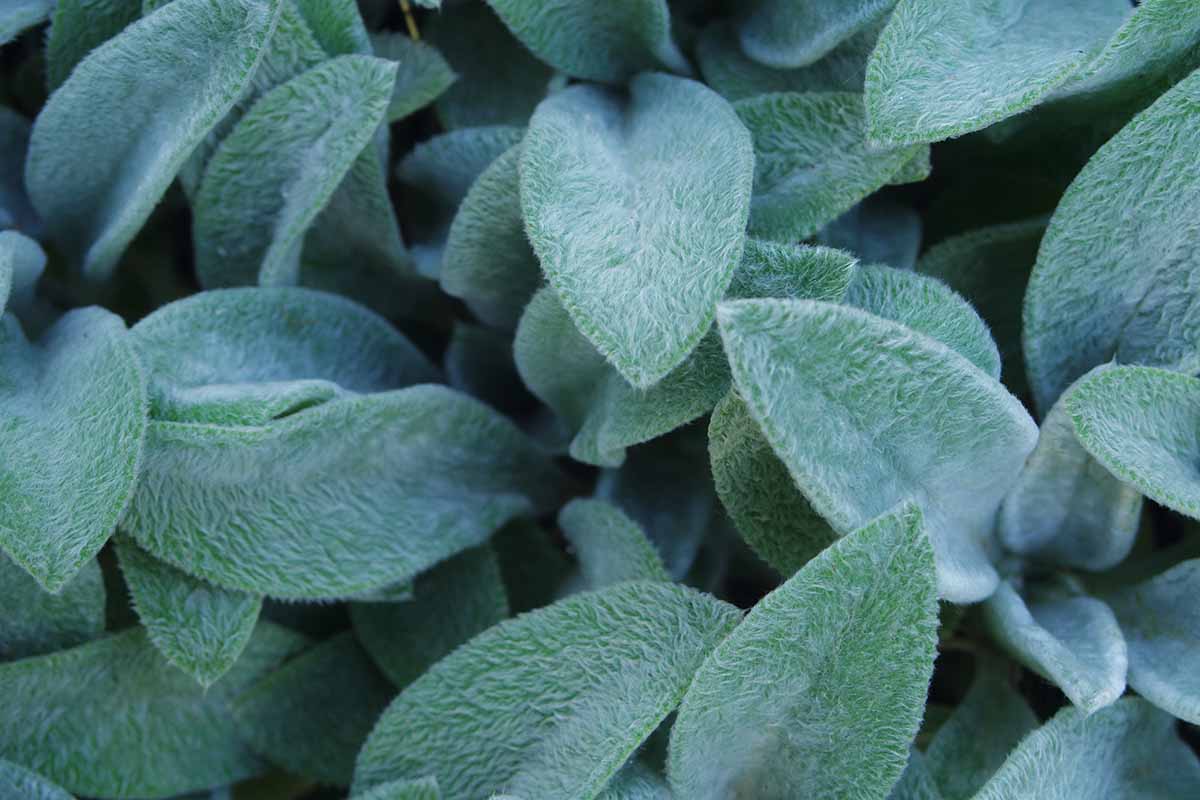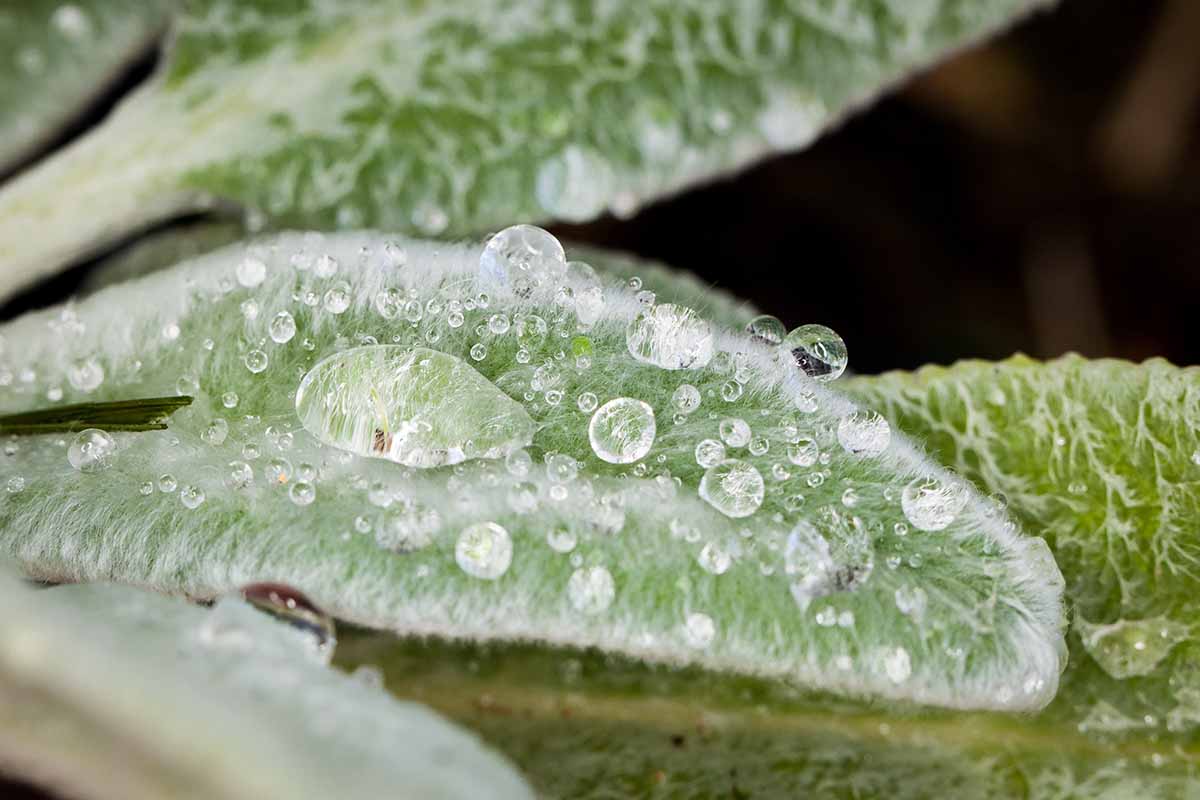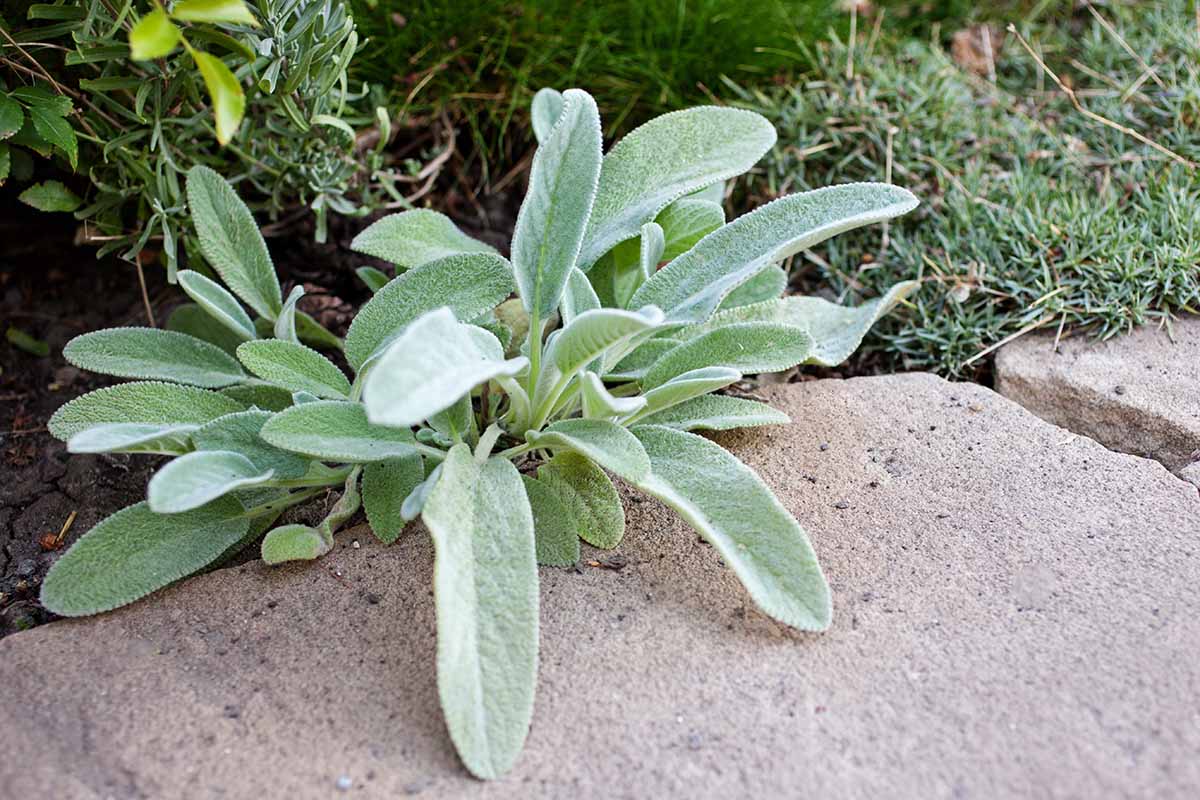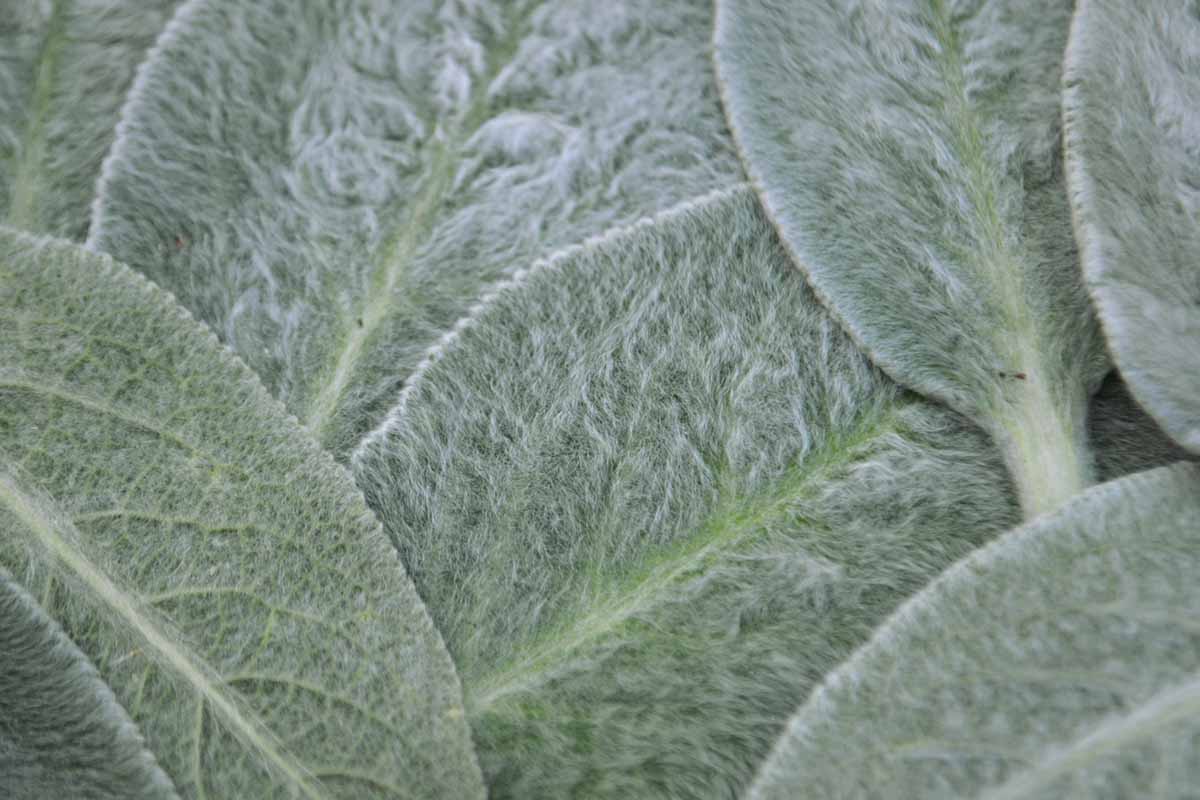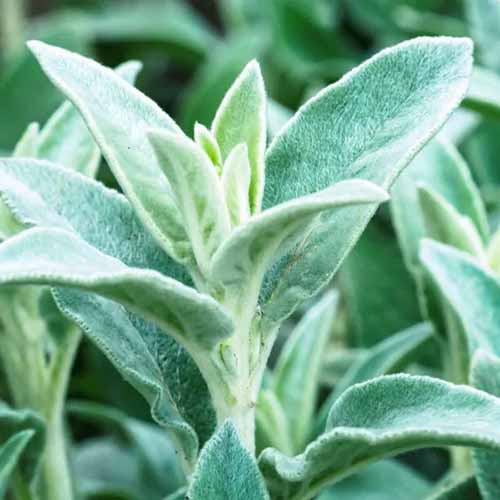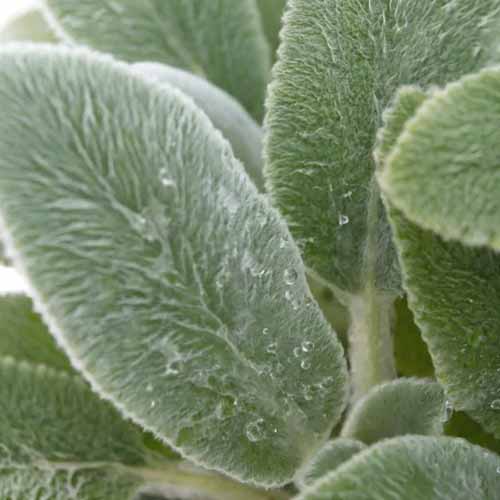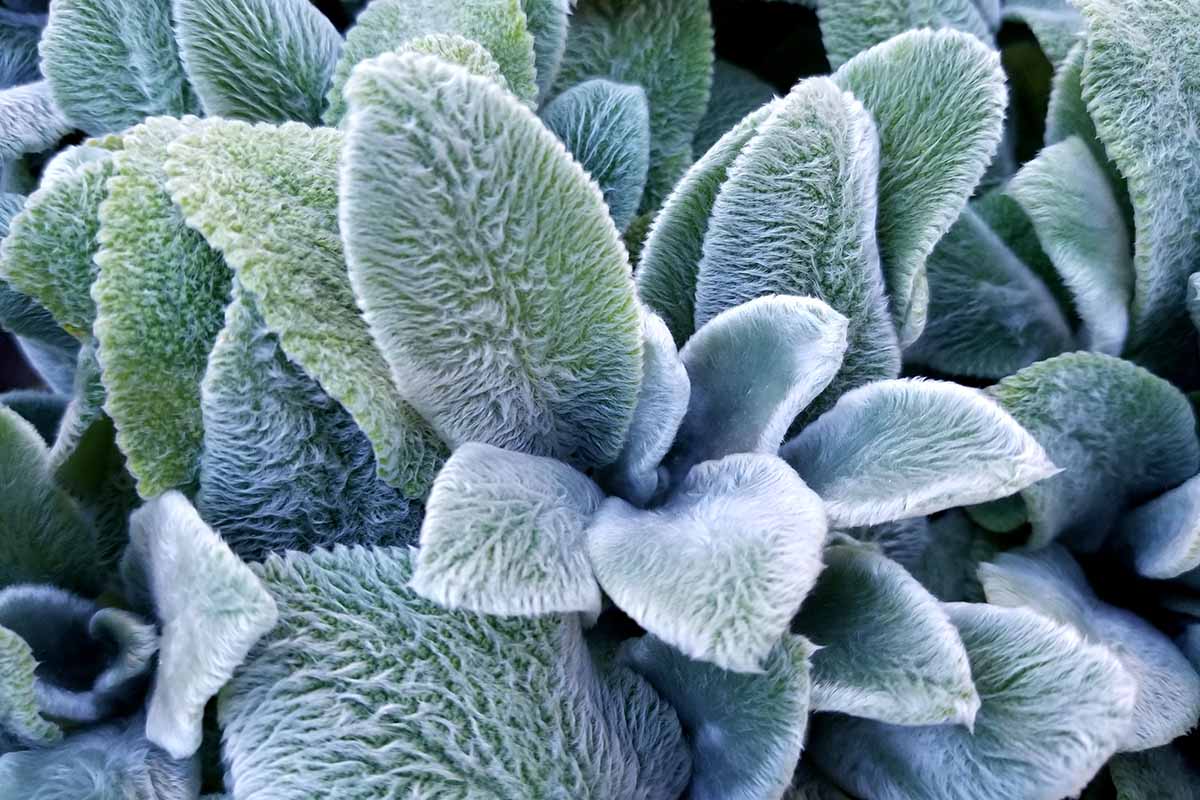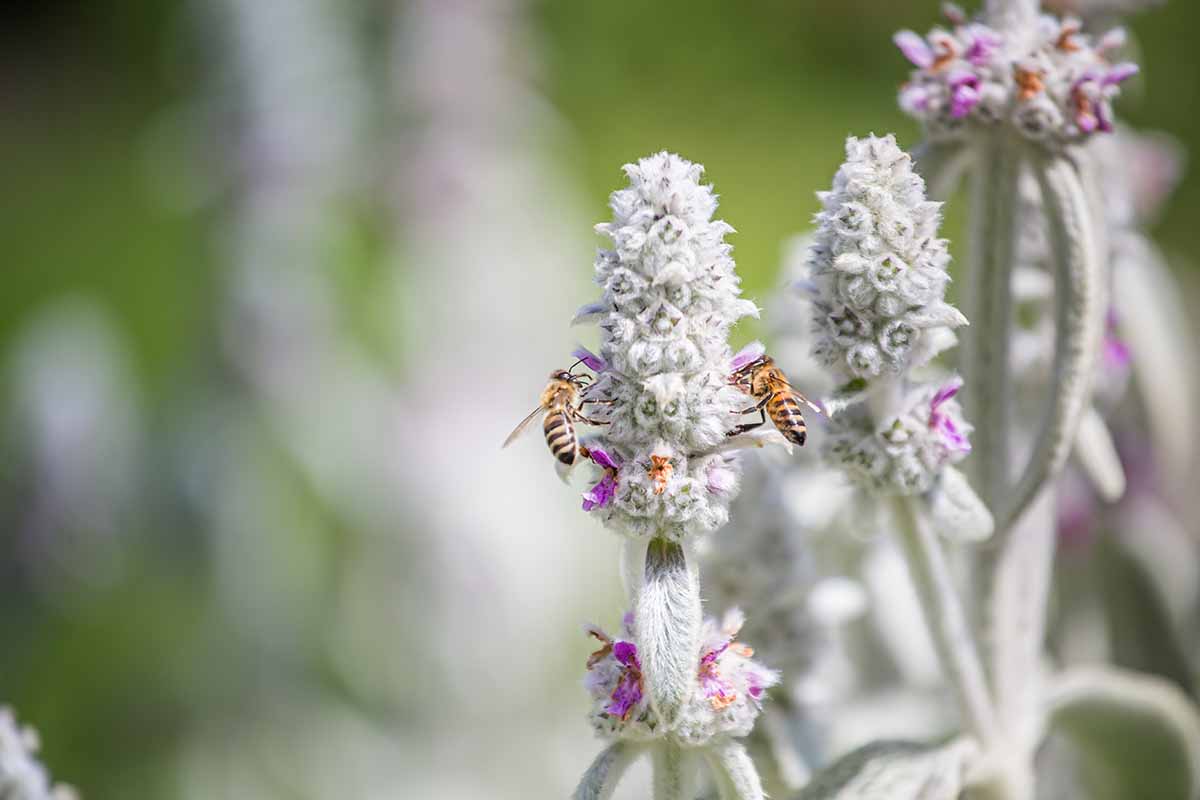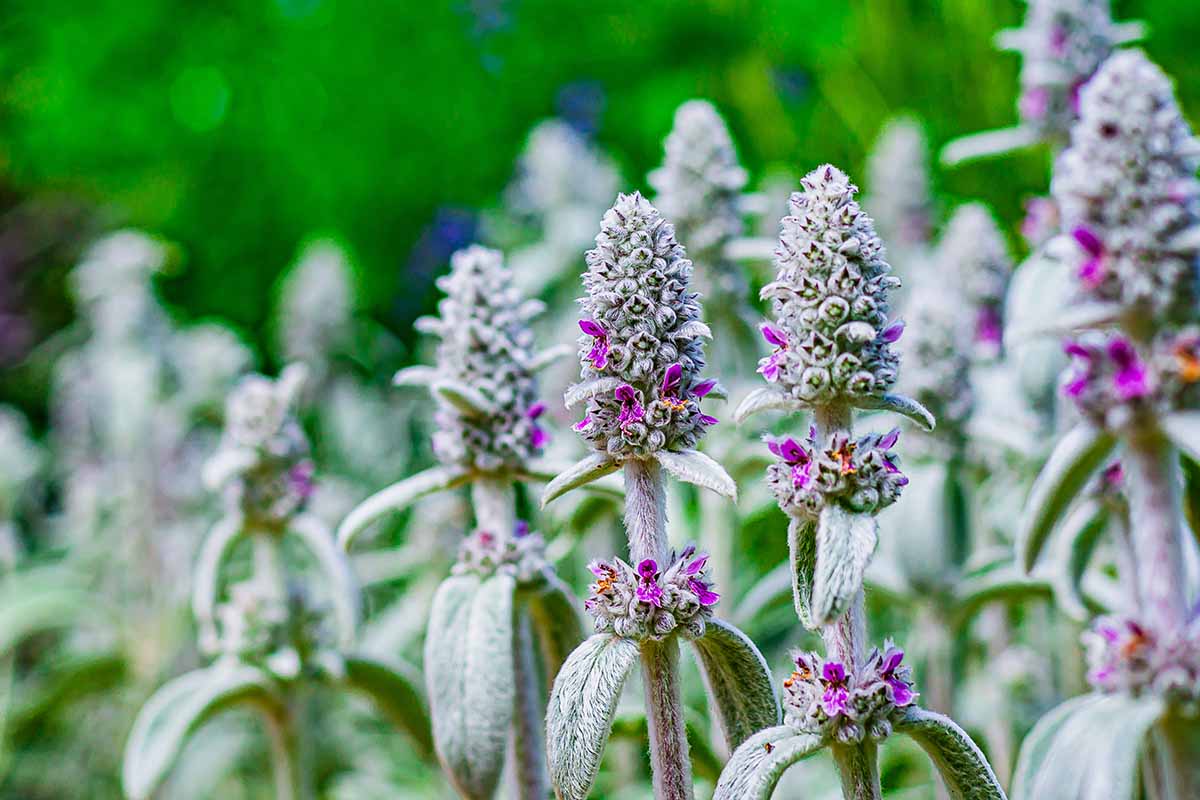It’s also surprisingly easy to grow, since the only thing it doesn’t like is soggy soil. In fact, lamb’s ear is drought resistant and only needs to be watered once a week in most zones, though it may require water more often in particularly hot and dry conditions. We link to vendors to help you find relevant products. If you buy from one of our links, we may earn a commission. This perennial grows best in USDA Hardiness Zones 4 through 9 and prefers full sun, but it can also be grown in partial shade. It is so versatile and hardy that it often spreads and becomes a good ground cover. It’s also known in some circles as a natural “band-aid” as the leaves have a history of use to treat ailments like bee stings. Let’s learn more about this famously fuzzy plant that offers beautiful texture to any landscape.
Cultivation and History
Lamb’s ears, also called wooly betony or woolly hedge-nettle, originated in the Middle East and thrives in USDA Hardiness Zones 4 through 9. Unsurprisingly, these common names denote the soft texture of the foliage, which is like the ears of a lamb. The leaves are even a similar size and shape to the ears of these animals, but their color, a silvery green, is quite different. S. byzantina belongs to the Lamiaceae family and is related to other popular plants like mint. The resemblance can be found if you look closely at the shape and structure of the leaves. However, this species is poisonous to many animals and shouldn’t be consumed. Despite its unassuming appearance, lamb’s ear has quite a rich history. Another nickname, “wooly woundwort,” references its usefulness as a bandage, due to its astringent properties. The leaves were used to dress wounds or as toilet paper in medieval times, and they were also reportedly used as bandages in the American Civil War. Today it is used mostly as an intriguing landscape plant. Its texture makes it especially popular in sensory or therapy gardens, and it holds a place in historic gardens too, like George Washington’s gardens at Mount Vernon. The species plant can grow up to 30 inches wide and 32 inches tall, though many cultivars are smaller. Lamb’s ears is hardy and spreads quickly, which makes it a wonderful ground cover – but it needs to be pruned once a year. S. byzantina is drought tolerant and can grow in full sun or partial shade. In some gardens it may even become weedy and can quickly take over. For that reason, some people grow it in pots or small beds to contain its spread. Some varieties of lamb’s ear, like ‘Big Ears’ and ‘Silver Carpet,’ don’t produce flowers. If you want to keep your plants from spreading by self-seeding, choose a non-flowering variety.
Propagation
Lamb’s ears can be propagated by dividing existing plants or sowing seeds. While it can be grown from cuttings, the success rate for this propagation method is low, and it’s just as easy to divide mature plants instead.
From Seed
After flowering, with successful pollination, lamb’s ears produces fertile seeds. Buying seeds is a good way to gain access to more varieties, like ‘Primrose Heron’ and ‘Wave Hill.’ The most common variety to see in nurseries is ‘Big Ears,’ and it can be difficult to find rhizomes or live specimens of other cultivars. The seeds germinate in around 30 days, which can be discouraging – especially since they also tend to have a low germination rate. Many gardeners tend to overwater when propagating seeds, which often leads to mold problems before the seeds germinate, and in turn leads to a failure to grow. Use a porous seed-starting mix in trays or containers that drain well and avoid overwatering to combat these problems. Provide the germinating seeds with consistent moisture but don’t overwater. After the seeds have germinated, give the seedlings direct light. Once the risk of frost has passed, you can begin hardening off and transplanting your seedlings as described below. Bonivee Seed Starter Tray This will minimize the odds of mold forming, and give you more control over the moisture level inside. The seeds should be pressed gently into the soil, not covered. Seeds can also be directly sown into the garden in spring, once the risk of frost has passed. As you would if starting indoors, gently press the seed into the soil surface rather than covering it. Remember to keep the soil consistently damp for your seedlings, whether they are started indoors or out.
By Division
The most common way to propagate lamb’s ear is by dividing an existing plant. Not only is this faster than starting from seed, but it also has a higher success rate and takes advantage of the plant’s natural tendency to multiply. Early spring is the best time to divide mature lamb’s ears. When picking a new spot for your divisions, remember that they will need full to partial sun. You can prep the soil for planting your divisions by amending it with compost or worm castings. This will give the soil more organic matter while adding nutrients. Alternatively, you can use a slow-release granular fertilizer or water the plants in with a diluted liquid fertilizer. Prune back any old or weak growth. When you can clearly see the remaining primary plants, use a shovel to dig around the edge to loosen the soil. Dig under the roots and pull up a clump of rhizomes. Pull at the roots to divide the rhizomes into sections that are about the size of your palm, with leafy growth attached. For old lamb’s ears with very woody roots, a shovel can be used to divide them, but for most plants you will be able to pull the roots apart by hand. Try not to severely damage the plant but don’t worry too much if it suffers some breakage. If the lamb’s ear has already produced multiple rhizomes, it is hardy and will bounce back quickly. Dig holes that are big enough to hold the rhizomes, and set the divisions in place at the same depth at which they were growing before. Backfill with soil, and water well. Then water twice a week for the next month in the absence of rain, or until the plant is established.
Transplanting
You can find potted lamb’s ears in most garden centers in both spring and fall. Spring is the most common time to transplant, after the risk of frost has passed, but early fall is also suitable in most climates, including frost-free zones where the plants may stay green through the winter. If you have started your own lamb’s ears from seed, harden them off gradually over the course of a week by putting them outside for an hour or so each day. Gradually increase the time they spend outside until they can stay out for a full day. Prepare the soil with compost to improve drainage and add organic matter. Once you have selected a location and the soil is prepared, dig a hole as large as the plant’s container. Then gently remove the plant and place it in the hole at the same level as it was growing in the container. Backfill with soil. If you are transplanting multiples, give each one at least 12 inches of space on all sides. This will give the lamb’s ears ample room to spread and allow for proper airflow in between. Alaska Liquid Fish Emulsion Fertilizer I like Alaska Liquid Fish Emulsion Fertilizer, and it’s available in 32-ounce containers from Home Depot. This product is higher in nitrogen (5-1-1 NPK), which is good for foliage plants. If you are transplanting your lamb’s ear into a pot, select one that holds at least three gallons of soil to give it room to grow. The plant will still multiply via rhizomes in a container, so it will need to be divided and repotted every three years or so.
How to Grow
Lamb’s ears is extremely easygoing and forgiving, and it can grow in everything from sandy loam to shallow, rocky soil. The key is planting it in well-draining soil. If you have compacted or clay-type earth, use amendments like compost or sand to improve drainage. The soil should have a slightly acidic pH of 6.0 to 6.5 for optimal growth. You can test the soil pH and nutrients with a soil test from your local extension service, and amend as needed. When it comes to light, this species grows best in full sun but it will tolerate partial shade. In the shade it tends to look more green, since it produces fewer silvery hairs. Still, it will retain its fun, fuzzy texture. Watering is the primary consideration when caring for lamb’s ears. Don’t water from above since the foliage easily traps water, putting the leaves at increased risk of developing powdery mildew. Once established, lamb’s ears is drought tolerant and only needs to be watered once a week in most climates. In particularly harsh temperatures and times of drought, they can be watered up to twice a week as needed. When possible, gently water below the plant to minimize splashing and reduce the risk of spreading soilborne pathogens. And always avoid overwatering, since lamb’s ears easily develops root rot. Lamb’s ears can usually survive without fertilizer but it will help your plants to grow stronger. The most common way to fertilize is by applying a liquid fertilizer to the soil around the base of the plant. Slow-release fertilizer stakes are also popular and easy to use. The best time to fertilize is in early spring. This is because the plants are emerging from dormancy at this time, and will need more nutrients. In warm climates like that of Zone 9 where lamb’s ears remain evergreen, plants can be fertilized in the fall. In general, look for a fertilizer that is high in nitrogen since foliage is key to the plant’s health and appearance. Don’t fertilize seedlings until they are at least four weeks old, or otherwise it might burn.
Growing Tips
Plant in well-draining soil.Don’t overwater – lamb’s ear is susceptible to root rot.Plant in full sun for lush growth and vibrant color.
Pruning and Maintenance
Lamb’s ears spreads quickly and easily by both rhizomes and seeds, so it’s important to divide the plant often and watch for self-sowing. Plants should be divided every three or four years. Division is important for the health of the roots and to prevent general overcrowding, but also to allow for proper airflow. If air can’t circulate freely around the leaves, this increases disease risk. You should also remove old and dead leaves from the base of the plant. The best time to remove old leaves is in the fall, since lamb’s ear dies back in the winter in most regions. And the second best time for pruning and maintenance is in the spring, once new growth begins to appear. Old or dead foliage will appear yellow or brown and it will be closest to the crown. Removing it might take a little work, since the healthy leaves will hide old growth. To uncover the dead foliage, gently lift the healthy leaves and use sharp pruning shears to remove the old growth. Sanitize your shears between cutting to prevent the spread of disease. Proper pruning and upkeep will help to prevent the spread of disease and encourage healthy growth. It’s also a good idea to heavily prune your lamb’s ears once a year to encourage new, more compact growth. When trimming back plants or doing a heavy pruning, give them some fertilizer when you’re finished so they have enough nutrients to grow back strong. If you do not want your plants to spread via self-sown seed, you should deadhead the flowers. Many people cut the flowers off as they form so energy is focused on the foliage, or they may be enjoyed and cut back after they’re finished. Likewise, you can choose to grow a variety that does not produce flowers. If you want to prevent lamb’s ear from spreading via underground rhizomes, grow yours in a pot or contained bed. You should still plan to divide the new plants every three years or so to optimize airflow. Dispose of any offsets that you don’t wish to transplant elsewhere in the garden.
Pests
Animals rarely bother or eat lamb’s ears, and this species is notably deer and rabbit resistant. While they might eat them in extreme situations, like times of drought, most don’t like the texture of the leaves.
Big Ear
‘Big Ear,’ aka ‘Helene von Stein,’ is a common, mostly flowerless variety. As its name implies, it has large, silver-green leaves. ‘Big Ear’ It is larger than many other varieties, reaching up to 12 inches tall and 24 inches wide. If you want to add this popular cultivar to your garden, plants are available at Nature Hills Nursery.
Cotton Boll
‘Cotton Boll’ gets its name from its noticeably white flowers. This cultivar has leaves that are hairier than the ‘Big Ear’ or ‘Silver Carpet,’ resulting in a softer feel and a very silvery to white appearance. It is especially useful as a landscape plant since it allows other species to stand out.
Primrose Heron
If you are looking for a short variety with a lot of style, ‘Primrose Heron’ is the way to go. It only grows to 16 inches tall and 20 inches wide, but it is known for its lime-green to yellow foliage. Despite the color difference, ‘Primrose Heron’ still has the velvety texture lamb’s ear is known for. This cultivar also features small purple flowers that make it popular with pollinators.
Silver Carpet
‘Silver Carpet’ is one of the most popular varieties because of its thick foliage and namesake silver color. ‘Silver Carpet’ It only grows up to six inches tall and spreads 30 inches wide, making it an ideal ground cover. It rarely flowers, so you won’t have to deadhead it. If you want to bring this easygoing cultivar to your garden, find plants at Nature Hills Nursery.
Managing Pests and Disease
Lamb’s ear is low maintenance and resistant to certain hungry herbivores. However, it is susceptible to moisture-related diseases and certain pests. Be sure to start with well-draining soil and give each plant at least 12 inches of space for proper airflow. Slugs and snails like to hide under this plant. They rarely damage or eat the fuzzy leaves, but their presence isn’t good for other plants growing nearby. Avoid mulching around lamb’s ears since mulch also gives these pests a place to hide. While there are occasional reports of caterpillars eating the leaves, it is uncommon. In general, lamb’s ear is easy to care for, with its biggest problems being related to moisture-related diseases.
Disease
Lamb’s ear is susceptible to various diseases, especially those related to moisture, humidity, and overwatering. Root rot may set in when roots are kept damp for too long, rotting due to suffocation or fungal infection. It is most often a result of excessive watering and growing in soil that holds water. Once it has begun, there isn’t much you can do to reverse root rot. Signs include stunted growth and yellowing or wilted leaves. If you suspect your plant has root rot, loosen the soil around the base of and take a look at the root ball. If there are still some firm, white roots among the rotten ones, the plant has a fighting chance. Prepare the afflicted plant for transplanting by clearing away any dead roots. Be gentle with the firm roots that remain as they are vital to the plant’s survival. Replant in fresh soil with good drainage. Powdery mildew is caused by a fungus, Neoerysiphe galeopsidis, which doesn’t usually kill host plants but it does harm them. It can be hard to spot since its white to gray color and texture blends into the silvery-green leaves. Prevent powdery mildew before it becomes a problem by giving the plants proper spacing and airflow. Rust, like powdery mildew, is hard to spot on this plant’s textured leaves. If you suspect your lamb’s ear has rust, evidenced by yellow to brown or rust-colored spots, remove the affected leaves immediately and dispose of them in the garbage. Do not compost them.
Best Uses
Lamb’s ear is most commonly used as a soft border to contrast with sharp lines and edges. It is also a popular ground cover since it is prolific and easygoing. It does especially well in beds with bright and colorful plants that are also drought-tolerant, like marigolds or daylilies. Beneficial insects, like bees, also enjoy the flowers of this species, making it well-suited to pollinator and sensory gardens. It is even popular in cottage gardens because of its soft color and texture. It is drought tolerant, good for pollinators, and evergreen in certain zones. All in all, it’s forgiving and easy to grow, making it perfect for new gardeners. Do you use lamb’s ears or other intriguing species to add texture to your landscape? Tell us in the comments section below! For more information on growing flowers in your garden, check out these articles next:
15 of the Best Flowering Ground Covers to Meet Landscaping ChallengesBirds, Bees, and Beauty: Tips for Growing a Native Wildflower Landscape at HomeCollecting Flower Seeds: How and When to Harvest Seeds from the Garden for Planting
